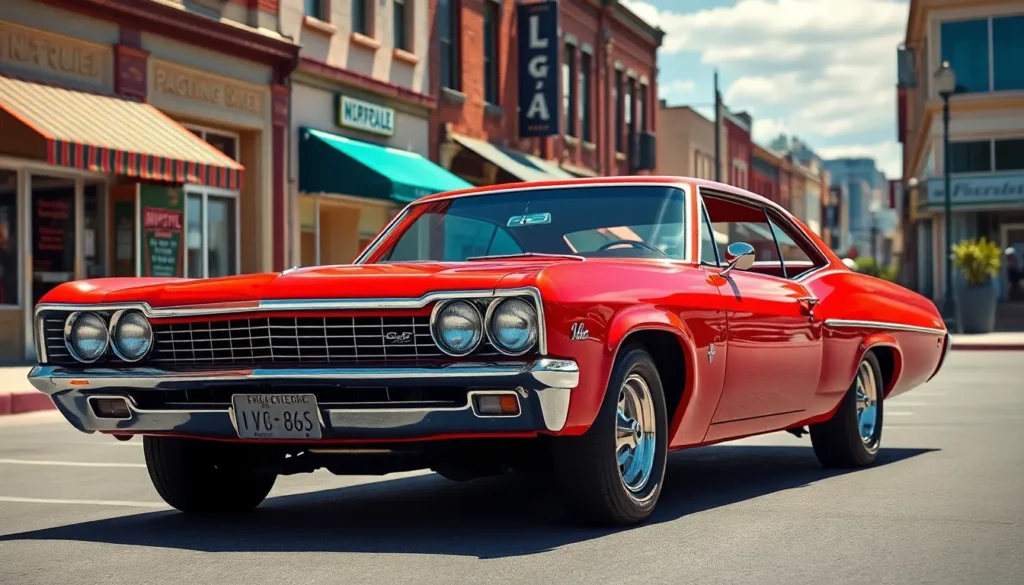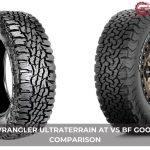The 1967 Chevrolet Impala stands as one of America’s most iconic muscle cars, representing the pinnacle of automotive design during the golden age of Detroit iron. We’re talking about a legendary vehicle that perfectly captured the spirit of the late ’60s with its aggressive styling, powerful engine options, and undeniable road presence.
What made the ’67 Impala so special? It’s the year Chevrolet completely redesigned their flagship model, introducing the distinctive “Coke bottle” silhouette that car enthusiasts still drool over today. This wasn’t just another family sedan – it was a statement piece that could cruise comfortably or unleash serious power when you pressed the pedal.
Whether you’re a classic car collector, restoration enthusiast, or simply curious about automotive history, we’ll explore why the 1967 Impala remains one of the most sought-after classics on the market. From its legendary SS variants to its cultural impact, this Chevy changed everything.
Design and Styling of the 1967 Chevrolet Impala
The 1967 Chevrolet Impala’s design represents a complete departure from its predecessors with revolutionary styling cues that transformed the American automotive industry. This redesign introduced the distinctive “Coke bottle” silhouette that became synonymous with late 1960s muscle car aesthetics.
Exterior Features and Body Lines
Sharp angular lines define the 1967 Impala’s profile, creating a dramatic contrast to the rounded designs of earlier models. The front end features dual headlights positioned within recessed chrome bezels that frame a horizontal grille pattern. Chrome bumpers extend across the full width of both front and rear sections, emphasizing the car’s substantial presence on the road.
Body proportions showcase the famous “Coke bottle” shape through pronounced fender flares that narrow at the center doors before expanding again at the rear quarters. Side sculpturing creates deep character lines that run from the front wheel wells to the rear taillights. The rear deck incorporates triple taillights on each side, arranged vertically in chrome housings that became an Impala signature design element.
Convertible models feature power operated soft tops while hardtop versions eliminate B pillars for a sleek, uninterrupted roofline. The SS variants add distinctive hood striping, special badging, and unique wheel covers that distinguish them from standard Impala models.
Interior Layout and Materials
Bucket seats in vinyl or optional leather upholstery create a sporty cabin atmosphere that complements the exterior’s aggressive styling. The dashboard features a horizontal design with round gauges clustered in front of the driver, including speedometer, fuel gauge, and temperature indicators.
Center console options include floor mounted automatic transmission shifters and additional storage compartments. Door panels incorporate matching upholstery materials with chrome accents and armrests positioned for optimal comfort during long drives. Rear bench seating accommodates three passengers with fold down armrests in premium trim levels.
Carpeting covers the floor areas in colors that coordinate with the interior color schemes. The steering wheel features a three spoke design with Chevrolet’s bowtie emblem centered in the hub. Air conditioning, power windows, and AM/FM radio options were available as dealer installed accessories.
Available Color Options
Exterior paint choices included 14 standard colors ranging from conservative tones to vibrant hues that captured the era’s bold aesthetic preferences. Popular selections featured Tuxedo Black, Ermine White, and Marina Blue alongside more adventurous options like Rallye Green and Bolero Red.
Two tone combinations paired contrasting colors on the roof and body sections, creating visual interest and customization opportunities. SS models offered exclusive paint schemes including special metallic finishes that weren’t available on standard Impala variants.
Interior color coordination matched exterior selections through complementary vinyl, cloth, or leather upholstery options. Common interior themes included black, blue, red, and parchment combinations that reflected the sophisticated color planning of General Motors’ design teams during this period.
Engine Options and Performance
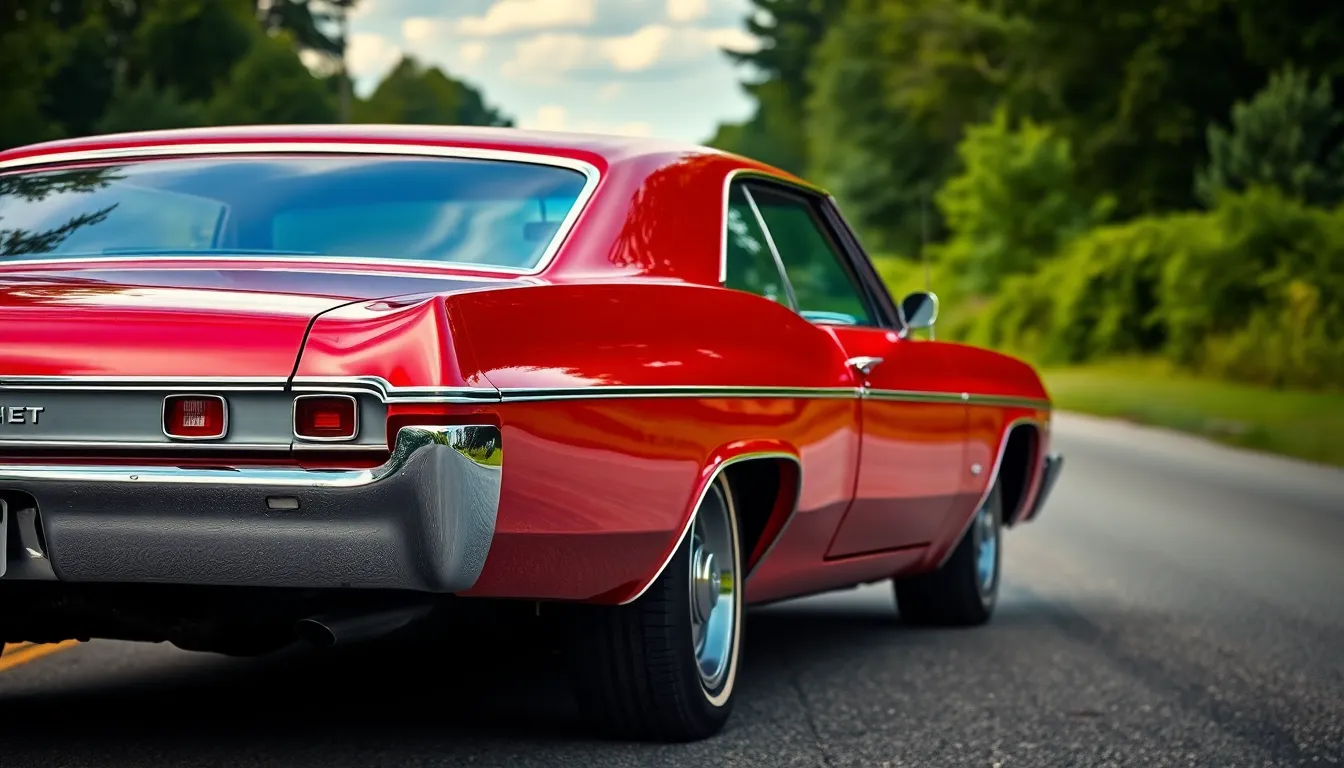
The 1967 Chevrolet Impala offered multiple engine configurations that catered to diverse driving preferences. Performance enthusiasts could select from various V8 powerplants that delivered exceptional acceleration and road presence.
Base Engine Specifications
Standard 1967 Impala models came equipped with a 283 cubic inch V8 engine that produced 195 horsepower. This two-barrel carburetor setup provided adequate power for daily driving while maintaining reasonable fuel economy. Torque output reached 285 pound-feet at 2,400 RPM, delivering smooth acceleration from low engine speeds.
| Engine Specification | Value |
|---|---|
| Displacement | 283 cubic inches |
| Horsepower | 195 hp |
| Torque | 285 lb-ft |
| RPM Range | 2,400 RPM |
| Carburetor | Two-barrel |
Optional buyers could upgrade to the 327 cubic inch V8 with 275 horsepower output. Four-barrel carburetion enhanced throttle response while increasing torque to 355 pound-feet. Compression ratio climbed to 10.25:1 for improved performance characteristics.
High-Performance V8 Options
Big block enthusiasts gravitated toward the legendary 396 cubic inch V8 available in multiple configurations. Entry level 396 engines delivered 325 horsepower through four-barrel carburetion and hydraulic lifters. Performance variants produced 350 horsepower with enhanced camshaft profiles and improved breathing capabilities.
SS models featured the most potent 396 variant generating 375 horsepower at 5,600 RPM. Solid lifter camshafts and 11:1 compression ratios transformed acceleration dynamics significantly. Quarter-mile times dropped into the mid-14-second range with proper tuning and driver technique.
| 396 V8 Variants | Horsepower | Torque | Features |
|---|---|---|---|
| Base 396 | 325 hp | 410 lb-ft | Hydraulic lifters, 4-barrel carb |
| L34 396 | 350 hp | 415 lb-ft | Enhanced cam, improved heads |
| L78 396 | 375 hp | 415 lb-ft | Solid lifters, 11:1 compression |
Special order customers accessed the limited production 427 cubic inch V8 rated at 385 horsepower. Aluminum intake manifolds and aggressive camshaft specifications created formidable straight-line performance. Production numbers remained extremely low due to cost considerations and insurance restrictions.
Transmission Choices
Manual transmission options included the standard three-speed column shift configuration found in base models. Close ratio Muncie four-speed transmissions paired perfectly with high-performance engines for maximum acceleration potential. Gear ratios optimized power delivery across the entire RPM band.
Automatic transmission buyers selected the reliable Turbo Hydra-Matic 400 three-speed unit. Torque converter stall speeds matched exact engine combinations for optimal performance characteristics. Manual valve body modifications enhanced shift timing and firmness for racing applications.
Performance oriented buyers often chose the heavy-duty Muncie M21 four-speed with 2.20:1 first gear ratio. Rock crusher durability withstood repeated high-RPM launches and aggressive driving techniques. Hurst shifters provided precise gear changes and reduced throw distances for competitive driving scenarios.
Trim Levels and Variants
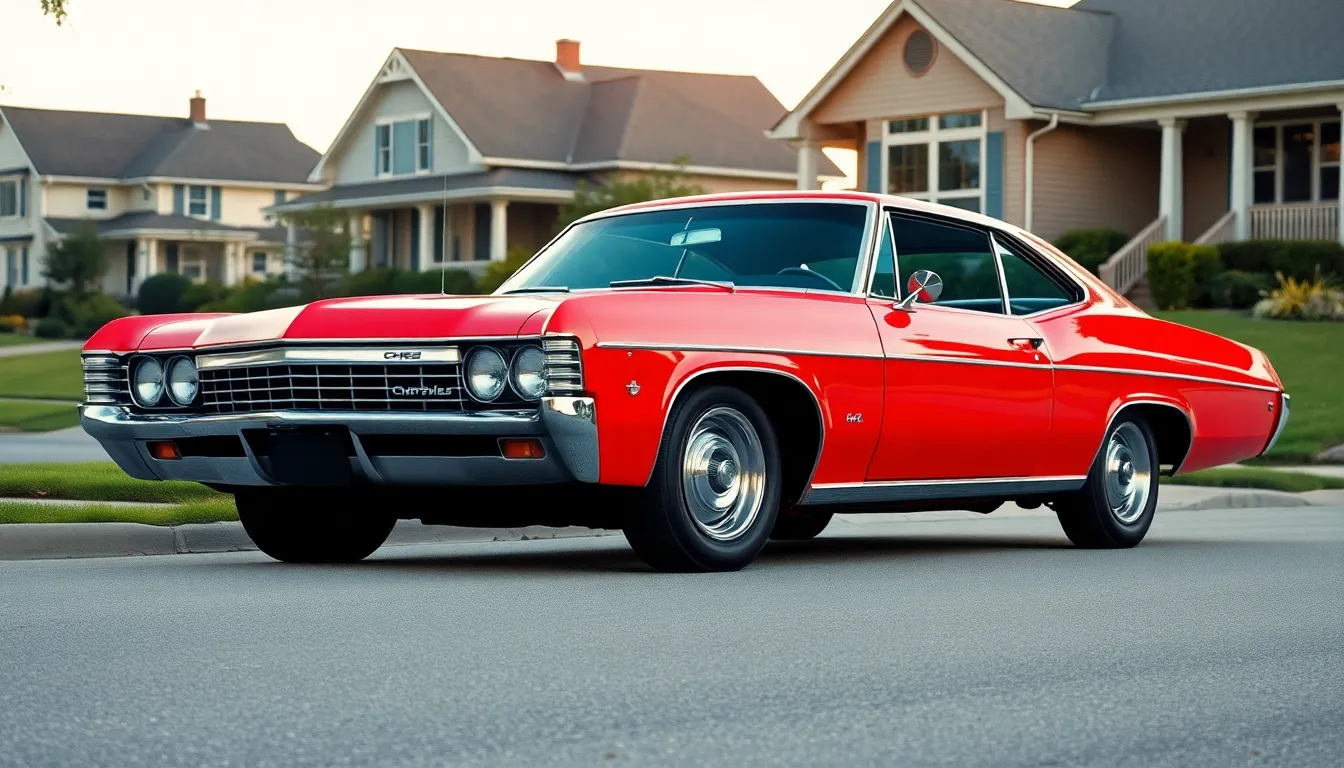
Chevrolet offered the 1967 Impala in three distinct trim levels, each targeting different market segments and performance preferences. Each variant featured unique styling elements and equipment packages that distinguished it from the others.
Impala Base Model
The base model Impala served as the entry point into Chevrolet’s full-size luxury lineup for 1967. Standard equipment included the 283 cubic inch V8 engine, three-speed manual transmission, and basic interior appointments with vinyl bench seats. Chrome trim appeared sparingly on the exterior, limited to bumpers, window surrounds, and minimal body side moldings.
Interior features consisted of a standard dashboard with basic gauges, AM radio preparation, and rubber floor mats in place of carpeting. Base models came with 14-inch steel wheels and dog dish hubcaps as standard equipment. These vehicles represented approximately 60% of total Impala production for the model year.
Price positioning made the base Impala competitive with Ford Galaxie and Plymouth Fury models in the mid-size luxury segment. Factory options allowed buyers to upgrade individual components without stepping up to higher trim levels.
Impala SS (Super Sport)
The Super Sport package transformed the standard Impala into a performance-oriented muscle car with distinctive visual and mechanical enhancements. SS models featured unique front and rear fascias, blacked-out grille with hidden headlights, and special SS badges throughout the exterior. Chrome exhaust tips, performance stripes, and rally wheels completed the aggressive exterior appearance.
Engine options for SS variants included the 327 cubic inch V8 with 275 horsepower as standard equipment. Performance enthusiasts could upgrade to the 396 cubic inch big block V8 in three configurations: 325 horsepower base version, 350 horsepower mid-level option, or the top-tier 375 horsepower L78 variant.
Interior appointments elevated the SS above base models with bucket seats, center console, and special SS instrumentation including a tachometer and oil pressure gauge. Floor-mounted shifters came standard with manual transmissions, while console-mounted selectors accompanied automatic options. Production numbers for SS models totaled 76,055 units across all body styles.
Convertible and Hardtop Options
Body style variations provided buyers with multiple roof configurations to suit their preferences and driving habits. Four-door sedans featured conventional door frames and fixed rear windows, appealing to families seeking maximum practicality. Two-door hardtops eliminated the center pillar for an uninterrupted side glass profile, creating a sleeker appearance favored by younger buyers.
Convertible models represented the premium end of the Impala lineup with power-operated soft tops and additional structural reinforcement. These vehicles included standard equipment upgrades such as power steering, automatic transmission, and upgraded interior trim to justify their higher price points.
| Body Style | Production Numbers | Starting Price |
|---|---|---|
| Four-door Sedan | 238,776 units | $2,774 |
| Two-door Hardtop | 220,114 units | $2,734 |
| Convertible | 9,545 units | $3,165 |
Hardtop models offered the visual appeal of convertibles while maintaining structural rigidity and weather protection. Convertible production remained limited due to higher manufacturing costs and specialized equipment requirements, making these variants particularly desirable among collectors today.
Key Features and Equipment
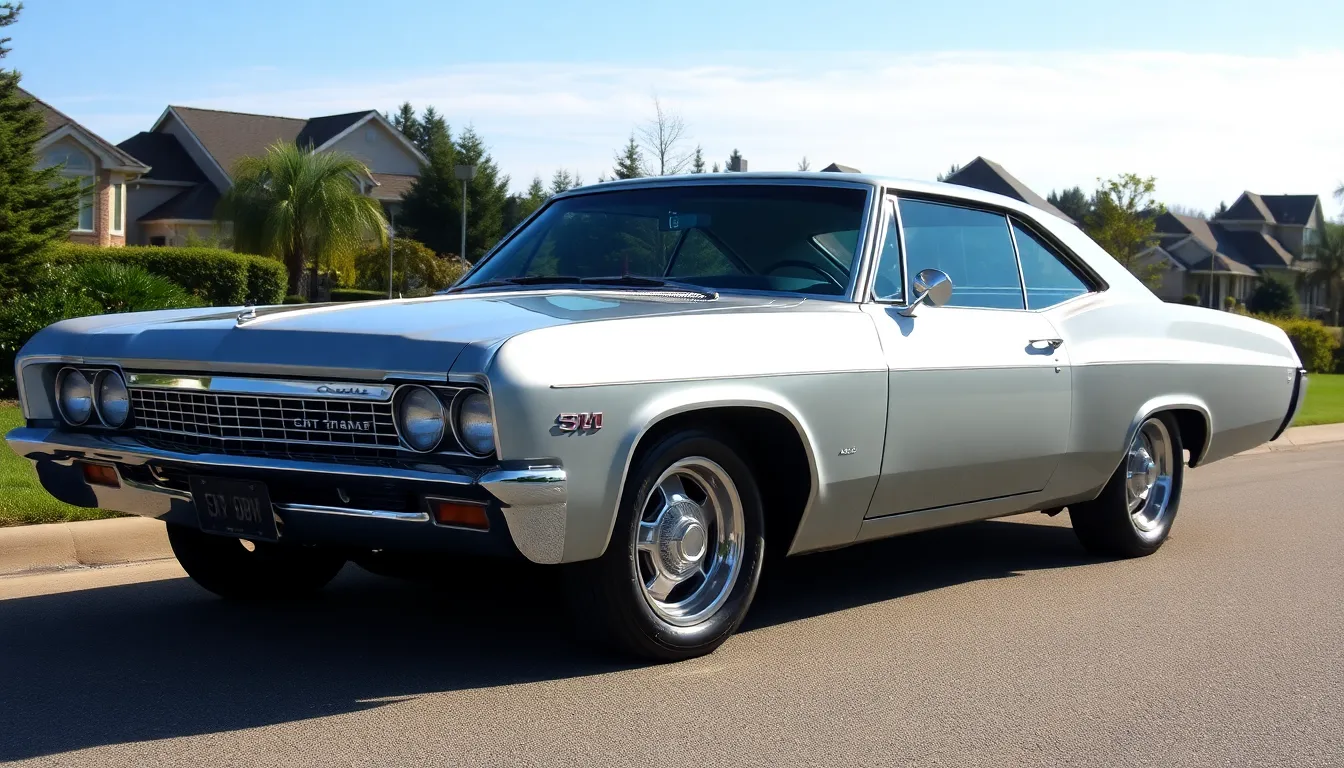
The 1967 Chevrolet Impala came equipped with an impressive array of standard features that distinguished it from competitors in the full-size luxury segment. Chevrolet designed comprehensive equipment packages to appeal to buyers seeking both comfort and functionality.
Standard Equipment Package
Standard equipment on the 1967 Impala included electric windshield wipers, dual speed electric heater and defroster, and chrome exterior trim that enhanced the car’s distinctive styling. Base models featured vinyl bench seats with foam cushioning, providing comfort for up to six passengers in the spacious interior.
We find that automatic interior lighting activated when doors opened, while the standard instrument cluster displayed essential gauges including speedometer, fuel gauge, and temperature warning light. Chrome bumpers front and rear protected the body from minor impacts, and the standard 14-inch wheels wore 8.25 x 14 tires for reliable road performance.
Interior appointments included carpeted floors throughout the passenger compartment, bright metal door handles, and courtesy lights for enhanced convenience. The standard radio delete plate allowed buyers to specify their preferred audio system, while power steering became available as an affordable upgrade option.
Optional Accessories and Upgrades
Optional equipment packages significantly expanded the 1967 Impala’s capabilities and luxury appointments. Air conditioning represented the most popular comfort upgrade, featuring a powerful compressor system that maintained cabin temperatures even in extreme heat conditions.
Power brakes enhanced stopping performance through vacuum assist technology, particularly beneficial on SS models with high performance engines. We observe that power windows operated smoothly through electric motors, while power seats provided six-way adjustment for optimal driving positions.
Entertainment options included AM/FM radios, eight-track stereo systems, and rear seat speakers that delivered enhanced audio quality throughout the cabin. Chrome luggage racks, vinyl roof treatments, and wire wheel covers allowed owners to customize their Impala’s appearance according to personal preferences.
Performance enthusiasts could specify Positraction rear axles, heavy-duty cooling systems, and dual exhaust configurations that complemented the available V8 engines. Rally wheels, white stripe tires, and SS-exact trim packages transformed standard models into aggressive muscle car variants.
Safety Features
Safety equipment on the 1967 Impala reflected contemporary automotive standards with several innovative protection systems. Standard seat belts for front passengers provided basic restraint capability, while energy-absorbing steering columns reduced injury risk during frontal collisions.
Dual-circuit brake systems offered redundant stopping power if one circuit failed, representing advanced engineering for the era. We note that padded instrument panels and door trim reduced injury potential from interior contact during accidents.
Optional safety features included shoulder harnesses for front passengers, backup lights that illuminated the rear area during reverse operation, and side marker lights that improved visibility to other drivers. The available remote control mirror allowed drivers to adjust visibility without reaching outside the vehicle.
Head restraints became available as optional equipment, providing neck protection during rear-end collisions. Four-way hazard flashers warned other motorists of stopped or disabled vehicles, while the optional tinted glass reduced glare and interior heat buildup during sunny conditions.
Market Position and Pricing

The 1967 Chevrolet Impala positioned itself as a premium full-size vehicle that delivered exceptional value in the competitive automotive industry. Chevrolet strategically priced the model to attract both luxury-minded buyers and performance enthusiasts seeking accessible muscle car performance.
Original MSRP and Value Proposition
The 1967 Impala base model carried a manufacturer’s suggested retail price of $2,774 for the four-door sedan. Two-door hardtops commanded $2,776 while the convertible topped the lineup at $3,048. Super Sport packages added approximately $358 to the base price.
| Model Variant | Original MSRP |
|---|---|
| Four-Door Sedan | $2,774 |
| Two-Door Hardtop | $2,776 |
| Convertible | $3,048 |
| SS Package Addition | $358 |
Chevrolet’s pricing strategy positioned the Impala as an attainable luxury vehicle that undercut many premium competitors. The standard equipment package included features typically found on higher-priced models such as electric windshield wipers and chrome exterior trim. Performance options like the 396 cubic inch V8 provided exceptional horsepower per dollar compared to European sports cars costing twice the price.
Competition in the Full-Size Segment
Ford’s Galaxie 500 presented the Impala’s primary competition with similar pricing and performance capabilities. The Galaxie 500 XL matched the Impala SS’s sporty positioning while offering comparable V8 engine options. Plymouth’s Fury and Dodge’s Monaco competed directly in the full-size luxury market segment.
Pontiac’s Bonneville positioned itself slightly upmarket with premium interior appointments and higher base prices. Buick’s LeSabre attracted buyers seeking additional luxury features while maintaining Chevrolet’s competitive pricing structure. Oldsmobile’s 88 series offered similar performance credentials with distinctive styling cues that appealed to brand-loyal customers.
Mercury’s Monterey and Marquis models targeted the same demographic with Ford’s premium divisions competing for market share. Chrysler’s Newport provided luxury appointments at comparable price points while emphasizing ride comfort over outright performance. The Impala’s combination of styling sophistication and performance versatility gave Chevrolet a important advantage in this crowded marketplace.
Collectibility and Current Market Value
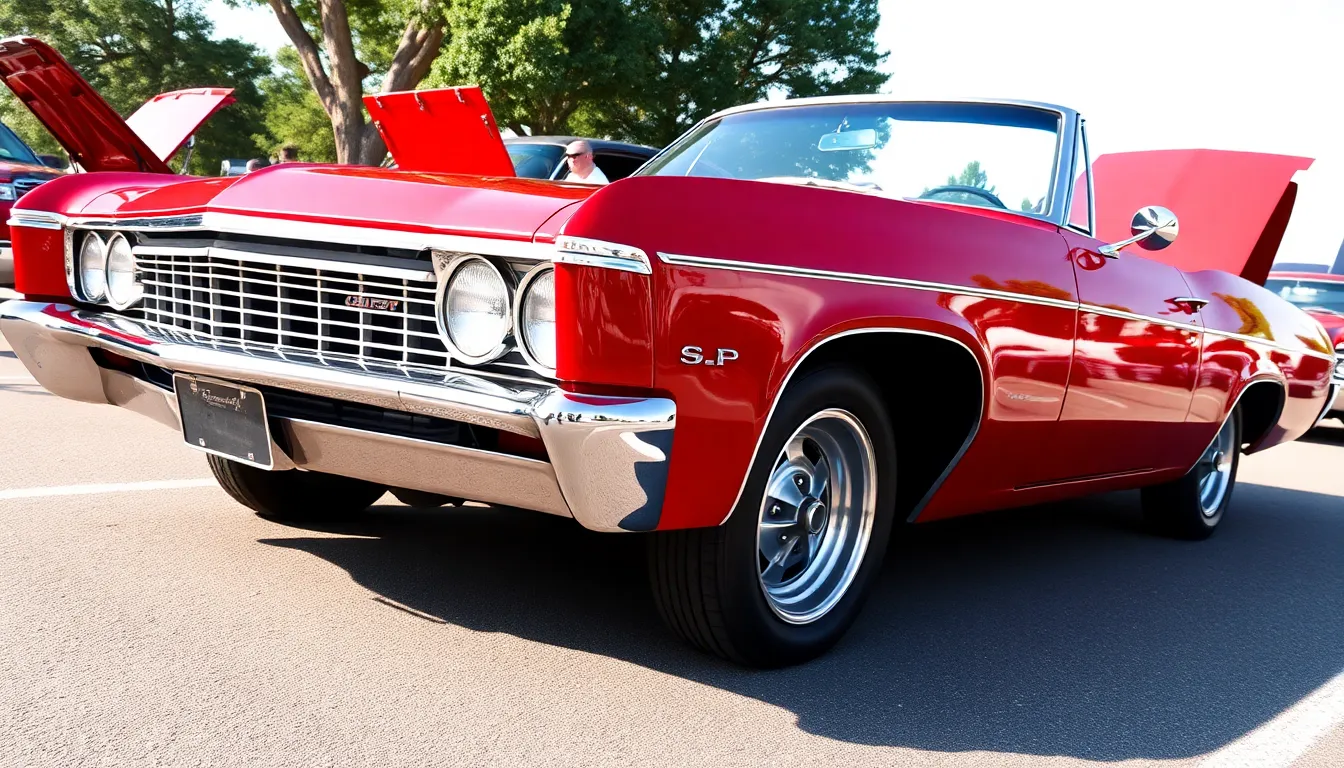
The 1967 Chevrolet Impala stands among the most coveted classics in today’s collector car market. Auction results consistently demonstrate strong demand across all trim levels and body configurations.
Factors Affecting Desirability
Engine configuration dramatically influences collector appeal in the 1967 Impala market. SS models equipped with the 396 cubic inch V8 command premium prices due to their documented performance credentials and limited production numbers. Base 283 cubic inch V8 variants attract entry-level collectors seeking authentic restoration projects at accessible price points.
Original documentation significantly impacts market desirability for these vehicles. Numbers-matching engine and transmission combinations verify authenticity and increase value by 15-25% compared to non-matching examples. Build sheets and dealer invoices provide crucial provenance that serious collectors prioritize during purchase decisions.
Body style rarity creates substantial value differentials within the 1967 Impala lineup. Convertible models represent only 9.4% of total production with 28,000 units manufactured, making them highly sought after by collectors. Four-door sedans account for the majority of surviving examples but generate less collector interest due to their family-oriented design focus.
Condition grades determine price positioning across regional auction markets. Concours-level restorations with professional paint and chrome work typically achieve 40-60% higher sale prices than driver-quality examples. Rust-free Western cars maintain important premiums over examples from salt-belt regions where corrosion affects structural integrity.
Color combinations influence collector preferences based on period-correct authenticity factors. Rally Red with black vinyl interior remains the most desirable SS configuration among enthusiasts. Marina Blue and Tuxedo Black exteriors paired with matching interior trim generate strong bidding activity at collector car auctions.
Investment Potential and Price Trends
Market values for 1967 Impala SS models have appreciated 127% over the past decade according to Hagerty Price Guide data. Entry-level examples in good condition averaged $18,500 in 2014 compared to current market values of $42,000 for similar vehicles.
| Trim Level | 2014 Average | 2024 Average | Appreciation |
|---|---|---|---|
| Base V8 Four-Door | $8,500 | $16,200 | 91% |
| SS 396 Hardtop | $18,500 | $42,000 | 127% |
| SS 396 Convertible | $28,000 | $67,500 | 141% |
| 427 SS Models | $45,000 | $95,000 | 111% |
Restoration costs significantly impact investment calculations for project vehicles. Professional frame-off restorations typically range from $35,000 to $55,000 depending on original condition and desired finish quality. Parts availability remains excellent through specialty suppliers and reproduction manufacturers.
Regional market variations affect pricing dynamics across different geographic areas. California and Arizona markets consistently show 10-15% premiums due to rust-free inventory and strong collector demand. Midwest auction results often present value opportunities for buyers seeking quality examples at competitive prices.
Future appreciation potential appears strong based on demographic trends and cultural significance factors. Gen X collectors entering peak earning years demonstrate increasing interest in 1960s muscle cars including the 1967 Impala. Limited production numbers combined with attrition through accidents and poor storage conditions continue to constrain available inventory.
Insurance companies recognize these vehicles as appreciating assets with agreed-value policies available through specialty carriers. Annual mileage restrictions typically range from 2,500 to 5,000 miles while requiring secure garage storage to maintain coverage eligibility.
Common Issues and Maintenance Considerations
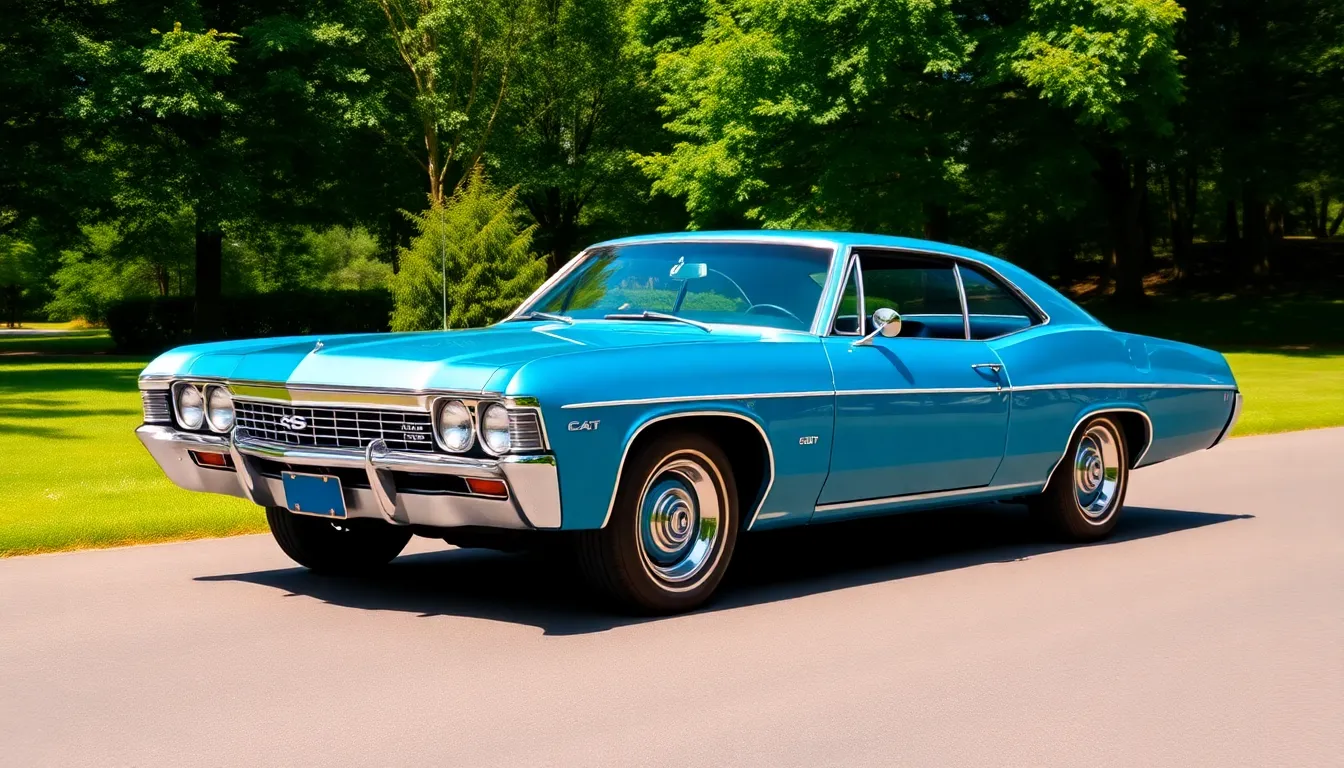
Even though its legendary status and robust construction, the 1967 Chevrolet Impala presents exact maintenance challenges that collectors and restorers frequently encounter. Understanding these common problems helps owners preserve their classic muscle car’s performance and value.
Known Problem Areas
Rust formation represents the most important threat to 1967 Impala longevity, particularly affecting the rear quarter panels, trunk floors, and rocker panels. Frame deterioration occurs most commonly around the rear spring mounts and front subframe connection points where moisture accumulates over decades.
Engine compartment issues typically involve carburetor problems in the Rochester Quadrajet units found on 396 and 427 engines. Fuel delivery systems experience deterioration in rubber fuel lines and fuel pump diaphragms after extended periods of inactivity. Transmission problems frequently manifest in the Powerglide automatic units through slipping bands and worn clutch packs.
Electrical system malfunctions commonly affect the alternator charging circuits and gauge cluster connections. Wiring harnesses deteriorate in the engine bay due to heat exposure and under-dash areas from moisture infiltration. Power window mechanisms fail regularly in convertible and hardtop models through worn motor brushes and binding regulator tracks.
Suspension components show wear patterns in the upper and lower ball joints, particularly on vehicles equipped with heavy big-block engines. Steering boxes develop excessive play through worn sector shafts and pitman arm connections. Brake system problems center around master cylinder failures and rear brake drum scoring from neglected maintenance.
Air conditioning systems in equipped vehicles suffer from compressor seal failures and evaporator core leaks. Heater cores frequently develop pinhole leaks that contaminate interior carpeting and create persistent coolant odors.
Parts Availability and Restoration Tips
Reproduction parts availability for 1967 Impalas remains excellent across most categories, with specialized suppliers offering complete restoration catalogs. Classic Industries and Ground Up SS Parts maintain extensive inventories of body panels, trim pieces, and mechanical components specifically manufactured for this model year.
Original GM parts sources include salvage yards specializing in 1960s Chevrolet vehicles and online marketplaces where enthusiasts sell authentic components. NOS (New Old Stock) parts command premium prices but provide authenticity that reproduction pieces cannot match.
Engine rebuilding components are readily available through multiple suppliers, with complete rebuild kits offered for all V8 configurations including the rare 427 variants. Transmission parts remain accessible through specialized rebuilders who maintain extensive inventories of Powerglide and Turbo Hydra-matic components.
Interior restoration benefits from companies like PUI Interiors and TMI Products that manufacture seat covers, door panels, and carpeting in original colors and textures. Dash pad reproduction has improved significantly with vacuum-formed pieces that match original grain patterns and mounting configurations.
Chrome restoration requires professional services due to the complex triple-plating process, with costs ranging from $200 to $800 per piece depending on size and condition. Paint matching presents challenges for original colors like Marina Blue and Bolero Red, requiring specialized automotive paint suppliers with period-correct formulations.
Documentation preservation enhances restoration accuracy through original shop manuals, parts catalogs, and assembly line photographs available from Chevrolet dealers and online archives. Professional restoration shops specializing in 1967 Impalas provide expertise in maintaining originality standards that preserve collector value and historical accuracy.
Conclusion
We believe the 1967 Chevrolet Impala stands as one of America’s most important automotive achievements. Its perfect blend of luxury comfort and muscle car performance created a blueprint that manufacturers still reference today.
The ’67 Impala’s enduring appeal lies in its accessibility to collectors at every level. Whether you’re drawn to a base model’s elegant styling or crave the raw power of an SS 427 we’ve seen how this classic continues to capture hearts and open wallets.
As we look toward the future we’re confident that the 1967 Impala’s values will continue climbing. Its combination of cultural significance timeless design and genuine performance credentials ensures its place among the most coveted classics in automotive history.
Frequently Asked Questions
What makes the 1967 Chevrolet Impala so iconic?
The 1967 Impala is considered iconic due to its revolutionary “Coke bottle” silhouette design, powerful V8 engine options, and cultural significance in automotive history. Its unique combination of luxury appointments, performance capabilities, and distinctive styling featuring sharp angular lines and chrome accents transformed it from a typical family sedan into a sought-after muscle car that epitomized late 1960s automotive design.
What engine options were available in the 1967 Impala?
The 1967 Impala offered several V8 engine configurations, starting with the standard 283 cubic inch V8 producing 195 horsepower. Optional upgrades included the 327 cubic inch V8 with 275 horsepower, the legendary 396 cubic inch V8 with variants ranging from 325 to 375 horsepower, and the rare 427 cubic inch V8 rated at 385 horsepower for ultimate performance.
What is the difference between the base Impala and SS models?
The base 1967 Impala served as Chevrolet’s entry-level luxury sedan, while the Super Sport (SS) package transformed it into a performance-oriented muscle car. The SS featured aggressive exterior styling elements, enhanced interior appointments, sport-tuned suspension, and access to high-performance engine options like the 396 cubic inch V8, making it significantly more powerful and visually distinctive.
What body styles were available for the 1967 Impala?
The 1967 Impala was available in three main body styles: four-door sedan, two-door hardtop, and convertible. The convertible models are particularly sought after by collectors today due to their limited production numbers and open-air driving experience, commanding premium prices in the current collector car market compared to sedan and hardtop variants.
How much is a 1967 Impala worth today?
Current market values for 1967 Impalas vary significantly based on condition, engine configuration, and body style. Base models attract entry-level collectors, while SS models with the 396 cubic inch V8 command premium prices. Convertibles and well-documented original examples typically bring the highest values, with the market showing strong appreciation potential over the past decade.
What are common maintenance issues with the 1967 Impala?
Common maintenance challenges include rust formation (particularly in the body panels), engine compartment issues related to aging components, and electrical system malfunctions typical of 1960s vehicles. Regular inspection of chrome trim, suspension components, and carburetor systems is essential. Fortunately, reproduction parts are widely available, making restoration projects more feasible for owners and collectors.
What safety features did the 1967 Impala include?
The 1967 Impala included several safety features that reflected the era’s automotive standards, such as standard seat belts, energy-absorbing steering columns, and optional shoulder harnesses. While basic by today’s standards, these features represented significant safety improvements for the time period and demonstrated Chevrolet’s commitment to passenger protection in their full-size luxury lineup.

